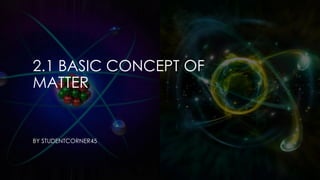
Understanding the Basic Concept of Matter
- 1. 2.1 BASIC CONCEPT OF MATTER BY STUDENTCORNER45
- 2. 1) Any substance that has mass and volume is considered matter. 2) Matter can exist in three physical states ; solid, liquid and gas. 3) For example, water exist as ice , liquid and steam. 4) The kinetic theory describes the movement and behaviour of the particles in the form of solids, liquids and gases. 5) The kinetic theory of matter states that a) matter consists of tiny discrete particles known as atom,molecule or ion. b) these particles are in continuous constant motion. Atom Molecule Ion • Smallest particle that take part in a chemical reaction. • E.g. sodium(Na) , magnesium(Mg) , carbon(C) , hydrogen (H). • Consists of two or more atoms joined by chemical bonds. • E.g. oxygen(O2) , water (H2O) , and carbon dioxide (CO2). • Positive charge – cation(atom loses electron) • Negative charge –anion (atom gain electron) • E.g. sodium ion (Na+) , aluminium ion (Al3+) , chloride ion (Cl-). STUDENTCORNER45
- 3. Solid Liquid Gas Arrangement of particles • Closely packed • Arranged in an orderly manner • Further apart • Not arranged in an orderly manner • Very far • Not arranged Movement of particles Vibrate about the fixed position Vibrate, rotate and move freely around Vibrate, rotate and move freely around at high speed Attractive force between particles Strong Weak Very weak and almost negligible Kinetic energy Low Moderately high High Other properties • Definite shape • Incompressible • Fix volume • Take the shape of the container • Slightly compressible • Fix volume • Take shape of container • Easily compressible • No fix volume STUDENTCORNER45
- 4. Evidence for the kinetic theory of matter are diffusion and the changes in the state of matter. DIFFUSION 1. Diffusion occurs when particles of one substance move through the space between particles of another substance. 2. Diffusion spreads out the particles aver a large area, 3. Gases diffuse very quickly as the particles have a higher energy and move very fast. There is also more empty space between the particle to move about. 4. For example, diffusion of bromine gas. 1. Liquids and solid diffuse very slowly as the particle have lower energy and move slower. 2. For example, potassium manganate(VII) solution dissolves in water. STUDENTCORNER45
- 5. Changes in the state of matter. Inter-conversion of state of matter 1. Matter can change from one state to another if heat is absorbed or released from it. 2. The change in temperature will influences the kinetic energy or the speed of the motion of the particles. 3. The kinetic energy of the particles in a substance is directly proportional to the temperature of the substance. Melting is a process in which solid changes into liquid upon heating at a certain temperature. AB: The temperature increase as heat energy is absorbed. The particles gain kinetic energy and vibrate vigorously. The substance exist in solid state. BC: The temperature remains constant as the heat is supplied is absorbed to overcome the forces of attraction that hold the particle in their fixed position. The substance exists in solid and liquid states. The temperature at which a solid is converted to a liquid is known as melting point. CD: The particles gain more kinetic energy and move faster as temperature increase. The substance exists in liquid state. Freezing is a process in which liquid changes to solid upon cooling at a certain temperature. RS: The temperature decreases as the heat energy is released to the surroundings. The particles lose kinetic energy and move closer together. The substance exists in liquid state, ST: The temperature remain constant as the heat energy released to the surrounding is balanced by the energy liberated to attract the particles together. The substance exists in solid and liquid states. The temperature at which a liquid is converted to a solid is known as freezing point. TU: The particle move slower as they lose heat energy as temperature decrease. The substance exists is solid state.STUDENTCORNER45
- 6. Supercooling only occurs if the solution is cooled too quickly and not properly stirred during the cooling process. EXERCISE 1) WHICH PROCESS OCCURS WHEN IODINE CRYSTALS ARE HEATED AT ROOM TEMPERATURE AND PRESSURE? A. MELTING B. FREEZING C. EVAPORATION D. SUBLIMATION 2) TABLE BELOW SHOWS THE BOILING POINT AND MELTING POINT OF SUBSTANCES, V,W,X AND Y. Fun Facts Subtances Boiling point (°C) Melting point (°C) V 268 197 W 170 150 X 130 80 Y 17 8 Which substance is a liquid at 100°C ? A. V C. X B. W D.Y ANS 1)D 2)C STUDENTCORNER45